Airfix 1/48 Spitfire I – the first successful Spitfire in combat
The first Spitfire is immortal as “the plane that saved Britain” (even if Britain was really saved by the Hurricane) in the Battle of Britain. A delicate blend of aerodynamic excellence, the Spitfire I almost wasn't there to do its part in saving Britain.
R.J. Mitchell, the Spitfire's designer, was known for his series of racing seaplanes that culminated in the Supermarine S.6B, which won for Britain final ownership of the Schneider Trophy and was the first aircraft to post a speed record over 400 mph. Three years later, the Type 224, designed to official Air Ministry specifications, came a cropper for being everything the Spitfire would not: a pedestrian design powered by the wrong engine, with the wrong armament.
Mitchell immediately set to work on his own design of what he thought a “proper fighter” should be. It was entirely state of the art, with fully cantilever structure and stressed skin construction, equipped with retractable landing gear and an enclosed cockpit. As first designed it was under-gunned, with only four .303 caliber machine guns. Consultation with RAF figures he was acquainted with led to Mitchell changing the design to incorporate eight .303 Colt Browning machine guns, with 250 rounds per gun.
The Spitfire prototype first flew in March 1935 and was a winner from the beginning, requiring far fewer changes between prototype and production aircraft than was the case with the airplane that would be its arch-rival, the Messerschmitt Bf-109. With war clouds gathering so strongly that even the British could see them, the Spitfire was placed into mass production in 1937. The problem was that Mitchell had never designed an airplane to be mass-produced, and Supermarine had never mass-produced an airplane. The Spitfire took approximately 40% more man-hours to produce than the Bf-109 - primarily due to the beautiful elliptical wing. Supermarine did not know how to handle such widespread production and soon fell behind in deliveries. Fortunately, the “shadow” industrial system had been established, and a factory run by managers who understood mass production was established at Castle Bromwich to back up the Supermarine factory in Southampton. Eventually the majority of Spitfires would be produced at Castle Bromwich, particularly after the bombing of the Southampton factory in 1940.
The essential part of the Spitfire was the engine, which began as a development of the Rolls-Royce Kestrel and resulted in the Merlin. The initial Merlin 1 provided 950 hp using 87-octane av gas, and gave the Spitfire I a top speed of 350 mph. Further development of the Merlin and the adoption of 100-octane gas would up these figures when the Spitfire II entered production in 1940.
19 Squadron was the first to re-equip with the Spitfire I, in the summer before the Munich Crisis in 1938. Throughout the year between Munich and the outbreak of World War II in September 1939, there was a race to produce enough Spitfires to equip the RAF. Fortunately the Hurricane was far easier to produce and Hawkers had better industrial management. By the time the Main Event began after the fall of France in the summer of 1940, over 2/3 of the fighters that would defend in the Battle of Britain were Hurricanes.
Legend has it that Spitfires were supposed to take on the 109s while the Hurricanes went after the bombers. While this would have been desirable, the reality was that both aircraft fought whichever they ran across - bombers or fighters. Both aircraft suffered from inadequate high altitude performance, thus the 109s were usually met as they dove out of the sun from above.
The first Spitfire victories in World War II were gained by 603 “City of Edinburgh” Squadron of the Royal Auxiliary Air Force. On October 16, 1939, the Luftwaffe made its first attack on Great Britain, with a mission flown by Ju-88A-1s of KG 30 hoping to catch HMS Hood in the Firth of Forth. When they arrived, they discovered Hood had docked overnight and therefore they could not attack her since they were under orders not to drop bombs on British soil. The cruisers HMS Southampton and Edinburgh were anchored in the Firth of Forth and were attacked in separate waves. 602 and 603 Squadrons,based at RAF Turnhouse, were scrambled to intercept. Among the Spitfires was “A-Apple” (XT-A) L1070 of 603 Squadron, named “Stickleback” and flown by Flight Lieutenant Patrick “Patsy” Gifford. Leading Red Section, he caught Oberleutnant Sigfried Storp's Ju-88A-1 (4D+DH) after the bomber had dropped its bombs on the ships. Just as Storp reached the North Sea, Gifford emptied his guns into the bomber and it fell into the sea, the first victory credited to the Spitfire in the war.
On October 22, Gifford claimed a shared victory over an He-111 and on October 28 he shared in the destruction of an He-111 of Stab/KG 26, both times flying “Stickleback.” In November, Gifford was the first RauxAF officer placed in command of a regular RAF squadron, when he took over 3 Squadron flying Hurricanes. On May 10, 1940, the squadron was sent to France, where Gifford was killed in combat on May 15.
Today, there are eight original Spitfire Is that have been lovingly restored to flight.
THE KIT
The Airfix Spitfire I kit A05126 was released in 2015 and is a new design, not to be confused with the earlier Spitfire I that was based on the old Spitfire V kit released 40 years ago. This Spitfire kit is similar to the also-new Spitfire V kit, with a nicely-detailed cockpit and different canopy options that allow one to do a Spitfire I at any point in its development history. All control surfaces are separate and can be posed dynamically.
The kit includes three markings options. However, I decided to use the new Fundekals sheet “Early Spitfires Part 2,” which includes the decals for “Stickleback,” the first successful Spitfire in air combat.
CONSTRUCTION
If a modeler commits the radical act of following the new Airfix instructions, it is very easy to build the model and a good result is guaranteed. I began construction by painting all the parts for the cockpit while they were on the sprue trees, before assembling things. My one addition here was to use a set of Eduard photoetch early Sutton seatbelts.
These new Spitfire kits all have the gas tank separate. I have discovered that the best way to get things right is to assemble the fuselage completely before inserting the cockpit in position. This way, you can work on the fit of the gas tank from inside and out, and get it right so that there is no fiddling or use of Mr. Surfacer necessary. With careful assembly of the fuselage halves, one can also get rid of the centerline seam with a simple scrape-down. The cockpit will slip into the fuselage in position without difficulty.
I assembled the wings with the ailerons in the neutral position, and drooped the elevators. In assembling the wing, I found it was a good idea to glue the multi-part main gear legs together and attach them at the point of wing assembly once they had set up, which gets things right. The fiddly landing gear is really the only negative thing with this kit. I used the early windscreen without the armor glass, the “pole” radio antenna mast, and the early pitot tube, to make this early Spitfire I.
COLORS & MARKINGS
The model was painted with Tamiya RAF Dark Earth, RAF Dark Green and Sky, freehanded for the “A-scheme” camouflage paint job. The lower surfaces were painted with Tamiya silver for the front cowling and rear fuselage and lower horizontal stabilizers and elevators, with the black and white ID scheme under the wing. Fundekals points out that the gear legs, gear doors and wheel wells were all completely painted the surrounding underwing color.
The Fundekals are printed by Cartograf and go on without problem under a coat of Micro-Sol. The instructions, which are in an online PDF format, give complete instructions for placement, as well as all other marking information. When the decals were set, I applied a coat of satin clear, since Fundekals says that the early Spitfires were finished with a semi-gloss paint.
I attached the prop and unmasked the canopy, then attached the side flap. Since this was an airplane that was still being given peacetime-level maintenance, I did not weather or “ding” it.
CONCLUSIONS
This Airfix Spitfire is accurate in outline and detail. While not as detailed as the new Tamiya kit, it is also half as expensive, and when completed one can sit it next to a Tamiya Spitfire I and not know the difference from a distance of 3 feet. The kit is easy to build for modelers with moderate experience who are willing to follow the instructions and is highly recommended.
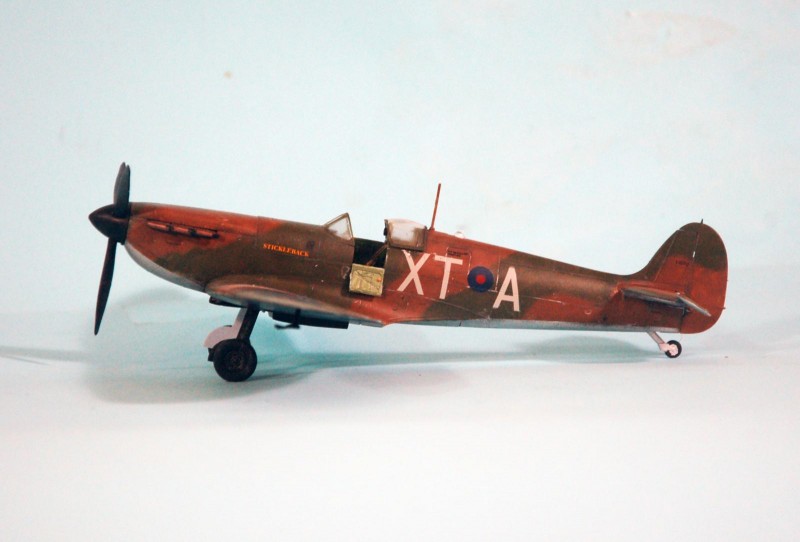

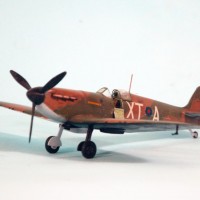
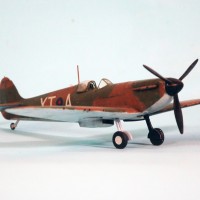
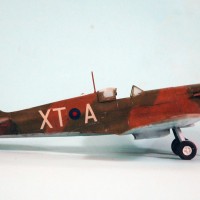
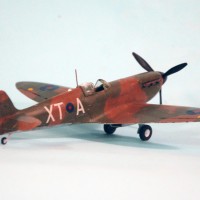
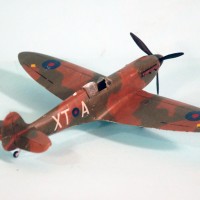
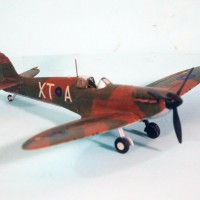

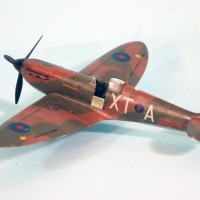

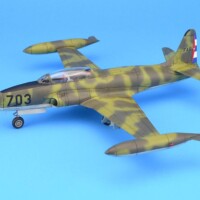
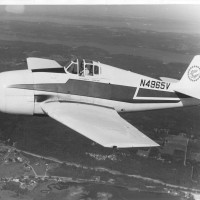
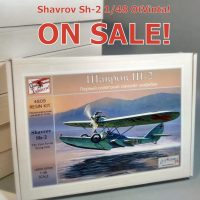
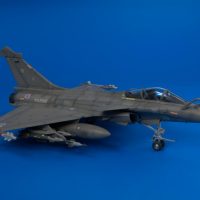
It's a great build Tom. Your output is prodigious and backed with good historical facts that many avoid. I haven't had a go at the Airfix Mk 1 but have both the old and the new Tamiya versions waiting for my pedestrian attention. Fantastic!
Paul
Nice looking Spitfire! The new Airfix kits are really nice.
Excellent build of one of the first of the "few."
Agreed on the landing gear.
I needed a big drop of CA glue at the base of each gear to keep my Airfix Spit from wobbling.
Great as always Tom. I'm in the finishing build stage of the Mk.Vb. On mine the instrument panel interfered with the cover so I ground out the cover and filed the top of the I.P.. This was probably because the original test fit of the cover over the bare fuselage halves stood way too proud so I sanded the bottom and got that flush. I'll use your tip when I get around to my Mk.I
Nicely done as usual, and a great overview.
fine looking ,"Piece of Cake"
You should call yourself Tom "Prolific", as you certainly are. Another fine build and write up of a very decent and fun kit for those who, as you say, "are willing to follow the instructions". I built mine as an early Mk. 1 with the two bladed prop.
another lovely build! Well done.
Outstanding as usual! It is the first time I read about the Spitfire’s “first blood”. Thanks!